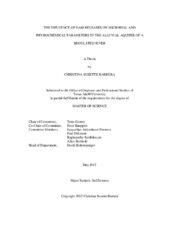| dc.description.abstract | Elevated fecal indicator bacteria in river systems is a continuing concern in Texas and throughout the United States. It has been discovered that bacterial concentrations in surface waters can increase drastically during elevated flow events. These events can be induced by natural, or anthropologic causes. An example of the latter is releases of large amounts of water from dams. These large releases of water to a river system may also influence the state of the surrounding alluvial groundwater. The aim of this study was to better understand changes in bacterial concentrations in the saturated alluvium approximately 19.3 kilometers downstream of the Tom Miller Dam, following regular, dam releases every 24 hours. A transect of 4 groundwater wells, at distances 1.5 to 6 meters from the river, was installed perpendicular to the bank of the Colorado River near Austin, TX. The wells were sampled every 4 hours over a 24-hour period. Field measurements were taken for temperature, electrical conductivity, pH and dissolved oxygen (DO). Laboratory tests were used to determine concentrations of total coliforms, fecal coliforms, E. coli, PO4-P, NO3-N, dissolved organic carbon (DOC), and total nitrogen (TN). Results indicated that the dam release had little impact on bacterial concentrations of the surrounding alluvium with increases detected only in the well closest to the river at peak water levels. During the time in which these samples were collected, the river system was under relatively low-flow conditions with the regular dam release only raising the water level about 0.06 m (0.2 ft) during sampling. Therefore, following sampling, the wells were fitted with pressure transducers to quantify lateral hydraulic gradients as a function of river level. Lateral hydraulic gradients confirmed the small dam releases, currently occurring upstream of the site, were not large enough to reverse the natural groundwater flow direction away from the river, consistent with the microbial and chemical results. | en |


